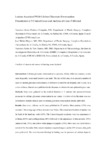Mostrar o rexistro simple do ítem
Lesions associated with calcium gluconate extravasation: presentation of 5 clinical cases and analysis of cases published
| dc.contributor.author | Pacheco Campaña, Francisco Javier | |
| dc.contributor.author | Midón Míguez, José | |
| dc.contributor.author | De-Toro, Javier | |
| dc.date.accessioned | 2024-04-16T11:01:16Z | |
| dc.date.available | 2024-04-16T11:01:16Z | |
| dc.date.issued | 2017-11 | |
| dc.identifier.citation | Pacheco Compaña FJ, Midón Míguez J, de Toro Santos FJ. Lesions associated with calcium gluconate extravasation: presentation of 5 clinical cases and analysis of cases published. Ann Plast Surg. 2017 Nov;79(5):444-449. | es_ES |
| dc.identifier.issn | 0148-7043 | |
| dc.identifier.uri | http://hdl.handle.net/2183/36212 | |
| dc.description | Review | es_ES |
| dc.description.abstract | [Abstract] Introduction: Calcium gluconate extravasation is a process, which, while not common, occurs more frequently in neonatal intensive care units. The aim of this study is to present a number of cases of calcium gluconate extravasation, which have occurred in our hospital, and to carry out a review of those clinical cases published in the literature to obtain relevant epidemiological data. Methods: Data were gathered on the medical histories of 5 patients who presented lesions secondary to calcium gluconate extravasation in our center. A review of the literature was also performed to include clinical cases of calcium gluconate extravasation already published. Results: Data were collected on 60 cases published in 37 articles. Most patients (55%) were neonates. The average age of these neonates was 8 days. The commonest location of injuries was the back of the hand and wrist (42%). The 2 most frequent symptoms were the appearance of erythema (65%) and swelling/edema (48%) followed by the appearance of skin necrosis (47%), indurated skin (33%), and yellow-white plaques or papules (33%). Most cases are cured within a period of 3 to 6 months. Fifty percent of patients required surgery, and in 13% of cases, skin grafts were performed. The most frequent histological finding was the presence of calcium deposits. Other histological findings described were the presence of necrosis, lymphohistiocytic infíltrate, and granulomas. Most histological findings were located in the dermis. Most x-rays showing calcium deposits had been performed at 3 to 4 weeks. Conclusions: Calcium gluconate extravasation is a process, which, although infrequent, is associated with serious skin and soft-tissue lesions, mainly affecting infants. Further studies are needed to determine possible specific procedures to be carried out in these cases. | es_ES |
| dc.language.iso | eng | es_ES |
| dc.publisher | Wolters Kluwer | es_ES |
| dc.relation.uri | https://doi.org/10.1097/sap.0000000000001110 | es_ES |
| dc.subject | Extravasation | es_ES |
| dc.subject | Calcium gluconate | es_ES |
| dc.subject | Soft tissue injuries | es_ES |
| dc.title | Lesions associated with calcium gluconate extravasation: presentation of 5 clinical cases and analysis of cases published | es_ES |
| dc.type | info:eu-repo/semantics/article | es_ES |
| dc.rights.access | info:eu-repo/semantics/openAccess | es_ES |
| UDC.journalTitle | Annals of Plastic Surgery | es_ES |
| UDC.volume | 79 | es_ES |
| UDC.issue | 5 | es_ES |
| UDC.startPage | 444 | es_ES |
| UDC.endPage | 449 | es_ES |
Ficheiros no ítem
Este ítem aparece na(s) seguinte(s) colección(s)
-
GI-TCMR - Artigos [131]






